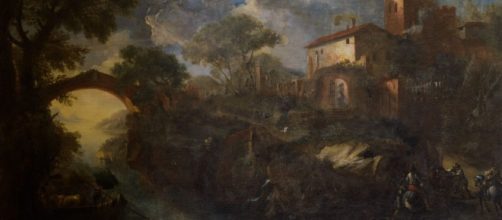His paintings sat for centuries in the Uffizi collection unidentified. Nobody ever heard of him. Now Rome’s Ministry of Foreign Affairs proclaims him as masterful as Caravaggio.
Out of the ghetto
Meet Jona Ostiglio, a Jewish artist in 17th-century Florence, where his people were held in ghettos and kept out of all professions including art.
Ostiglio would have remained buried in history if it weren’t for research by the Jewish Studies program director Piergabriele Mancuso of the Medici Archive Project.
Mancuso’s study reveals that the noted artist Giorgio Vasari invited Ostiglio, a self-taught painter, to join an art academy he founded.
The question is, how did a lone Jewish artist end up at a prestigious art school painting for some of Italy’s most prominent families?
Mancuso suggest the answer when he told the New York Times that Ostiglio was “unafraid to distance himself from rabbinical laws that would have him behave in a more orthodox manner.”
Having quit his religion, I’m left wondering why his ethnicity is relevant to this story, and why the print media continues to identify him with it – even in the headlines.
Making headlines
Art News magazine headline proclaimed: “Previously Unattributed Paintings at the Uffizi are by Jona Ostiglio, a 17th Century Jewish Artist Saved from Historical Obscurity.”
The New York Times went so far as to point up the very background that Ostiglio abandoned in this headline: “A New Focus on Jona Ostiglio, a Jewish Artist Who Broke Barriers in Medici-Era Florence.”
Ostiglio didn’t break barriers as a Jew.
He abandoned Judaism. So, when the Times says “scholars are puzzling” over the life of a Jewish painter at the Medici court, you have to ask why. There is no puzzle. Ostiglio relinquished his roots early on. End of that part of his story.
Bringing this painter back from obscurity would have been a lot more newsworthy if he had pictured ghetto life where his people were relegated to menial jobs like ragpickers.
Instead, according to Mancuso, Ostiglio was so good at “copying the great masters that one chronicler said it was impossible to tell his copies from the originals.” So, he not only wasn’t a Jewish painter, he didn’t make original art.
As I see it, discovering Ostiglio at the Uffizi would be like finding paintings in the National Gallery by a black slave who passed as white and who pictured scenes of bucolic innocence.
Isn’t that what Ostiglio did? Instead of picturing the struggles of his people during the Medici reign, he painted Arcadian scenery that all the news stories highlight.
There’s an irony here. The Führer would have loved Ostiglio’s work. Paradisical springtime settings – stainless and chaste – fit his agenda.
Hitler saw himself as the protector of "the right kind of art,'' uncontaminated by real life. Henry Grosshans’ 1983 book “Hitler and the Artists” quotes him saying: "Art must be cleansed of all manifestations of our rotting world."
Ostiglio’s work may have pleased Hitler, but it contributed nothing to art history. The hoopla about discovering him is unwarranted.


